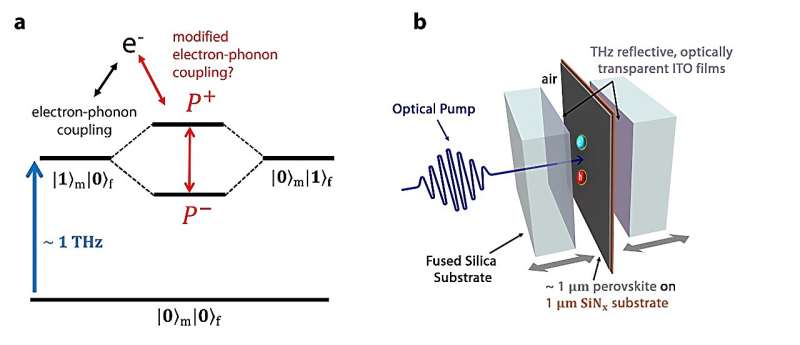This article has been reviewed according to Science X's editorial process and policies. Editors have highlighted the following attributes while ensuring the content's credibility:
fact-checked
peer-reviewed publication
trusted source
proofread
Controlling the electro-optic response of a perovskite coupled to a phonon-resonant cavity

Electron-phonon scattering is often the primary mechanism limiting electron mobility in semiconductors. Thus, changing phonon properties can provide a way to control conductivity. Recently, there has been a growing interest in exploring the use of the quantum nature of light as an alternative approach. In this method, the material properties are modulated by tuning its interaction with the vacuum state of the electromagnetic field.
The interaction between the quantum field and a two-level system causes the mixing of states |im|jf, composed of material (|im) and field (|jf) states, with different population quantum numbers i and j. Strong mixing of field and material states can be enhanced by placing the material inside a cavity tuned in resonance with the material two-level system transition. This method has previously been reported to affect the rate of chemical reactions and conductivity.
In a new paper published in Light: Science & Applications, a team of scientists, led by Professor Mischa Bonn from Max Planck Institute for Polymer Research, have developed an optically transparent terahertz cavity to manipulate phonon vibrations by coupling them to the vacuum state of an electromagnetic field inside the cavity. The cavity consists of two fused silica substrates, each with a deposited thin ITO layer.
This design allows photoexcitation of charge carriers in the material coupled with a THz cavity and probing the charge-carrier mobility using a THz pulse. The researchers examined the interaction between the THz cavity and a semiconducting perovskite (MAPI, (CH3NH3)PbI3).
MAPI possesses intense phonon modes in the THz frequency range, which can be strongly coupled with the THz cavity. These low-frequency phonons significantly impact the mobility of charge carriers in MAPI due to strong electron-phonon interactions that give rise to electron-phonon scattering. This scattering mechanism acts as the primary limitation to free charge motion in perovskite. Thus, a perovskite coupled with a phonon-resonant cavity could provide the opportunity to control on demand conductivity of perovskites.
The experiments demonstrated that both in the ground and excited state, the perovskite-cavity system response significantly depends on the cavity length and/or position of the perovskite within the cavity. Despite the drastically different-looking conductivity response between on-resonant and off-resonant cavity-perovskite configurations, classical electrodynamics is sufficient to explain the complex, non-intuitive response.
This suggests that the perovskite properties (i.e, refractive index or conductivity) are unchanged inside the THz cavity. However, the significant variability in the electro-optic response of the integral perovskite-cavity system allows for a tunable THz field modulation.
In conclusion, these scientists summarize their work:
"Tuning the cavity into resonance with the 1 THz perovskite mode increases the modulation up to 3-fold within the duration of THz pulse. Such on-demand adjustability of ultrafast THz field modulation can benefit photonic integrated devices and optical communications modulation."
"This work elucidates the role of cavity resonances in the presence of photoexcited media and opens the possibility of using a transparent THz optical cavity to shape the transmission of THz radiation and enhance, on-demand, THz field modulation through photoexcited semiconductor-cavity systems."
More information: Lucia Di Virgilio et al, Controlling the electro-optic response of a semiconducting perovskite coupled to a phonon-resonant cavity, Light: Science & Applications (2023). DOI: 10.1038/s41377-023-01232-0
Journal information: Light: Science & Applications
Provided by Chinese Academy of Sciences




















